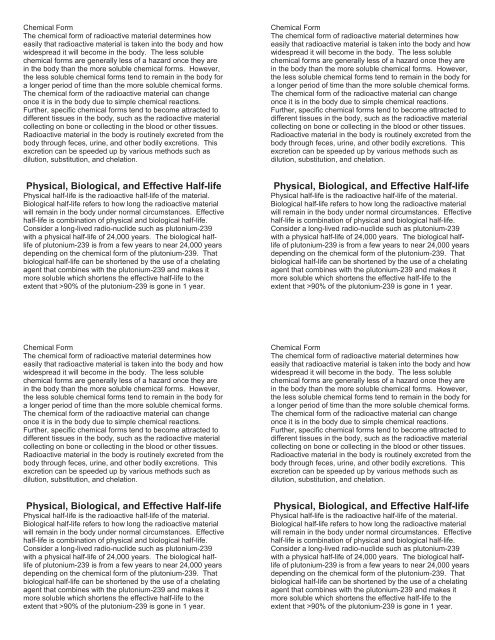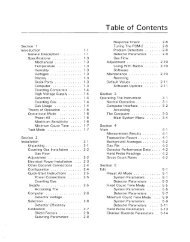Medical Physics Hand.. - Voss Associates
Medical Physics Hand.. - Voss Associates
Medical Physics Hand.. - Voss Associates
Create successful ePaper yourself
Turn your PDF publications into a flip-book with our unique Google optimized e-Paper software.
Chemical FormThe chemical form of radioactive material determines howeasily that radioactive material is taken into the body and howwidespread it will become in the body. The less solublechemical forms are generally less of a hazard once they arein the body than the more soluble chemical forms. However,the less soluble chemical forms tend to remain in the body fora longer period of time than the more soluble chemical forms.The chemical form of the radioactive material can changeonce it is in the body due to simple chemical reactions.Further, specific chemical forms tend to become attracted todifferent tissues in the body, such as the radioactive materialcollecting on bone or collecting in the blood or other tissues.Radioactive material in the body is routinely excreted from thebody through feces, urine, and other bodily excretions. Thisexcretion can be speeded up by various methods such asdilution, substitution, and chelation.Chemical FormThe chemical form of radioactive material determines howeasily that radioactive material is taken into the body and howwidespread it will become in the body. The less solublechemical forms are generally less of a hazard once they arein the body than the more soluble chemical forms. However,the less soluble chemical forms tend to remain in the body fora longer period of time than the more soluble chemical forms.The chemical form of the radioactive material can changeonce it is in the body due to simple chemical reactions.Further, specific chemical forms tend to become attracted todifferent tissues in the body, such as the radioactive materialcollecting on bone or collecting in the blood or other tissues.Radioactive material in the body is routinely excreted from thebody through feces, urine, and other bodily excretions. Thisexcretion can be speeded up by various methods such asdilution, substitution, and chelation.Physical, Biological, and Effective Half-lifePhysical half-life is the radioactive half-life of the material.Biological half-life refers to how long the radioactive materialwill remain in the body under normal circumstances. Effectivehalf-life is combination of physical and biological half-life.Consider a long-lived radio-nuclide such as plutonium-239with a physical half-life of 24,000 years. The biological halflifeof plutonium-239 is from a few years to near 24,000 yearsdepending on the chemical form of the plutonium-239. Thatbiological half-life can be shortened by the use of a chelatingagent that combines with the plutonium-239 and makes itmore soluble which shortens the effective half-life to theextent that >90% of the plutonium-239 is gone in 1 year.Physical, Biological, and Effective Half-lifePhysical half-life is the radioactive half-life of the material.Biological half-life refers to how long the radioactive materialwill remain in the body under normal circumstances. Effectivehalf-life is combination of physical and biological half-life.Consider a long-lived radio-nuclide such as plutonium-239with a physical half-life of 24,000 years. The biological halflifeof plutonium-239 is from a few years to near 24,000 yearsdepending on the chemical form of the plutonium-239. Thatbiological half-life can be shortened by the use of a chelatingagent that combines with the plutonium-239 and makes itmore soluble which shortens the effective half-life to theextent that >90% of the plutonium-239 is gone in 1 year.Chemical FormThe chemical form of radioactive material determines howeasily that radioactive material is taken into the body and howwidespread it will become in the body. The less solublechemical forms are generally less of a hazard once they arein the body than the more soluble chemical forms. However,the less soluble chemical forms tend to remain in the body fora longer period of time than the more soluble chemical forms.The chemical form of the radioactive material can changeonce it is in the body due to simple chemical reactions.Further, specific chemical forms tend to become attracted todifferent tissues in the body, such as the radioactive materialcollecting on bone or collecting in the blood or other tissues.Radioactive material in the body is routinely excreted from thebody through feces, urine, and other bodily excretions. Thisexcretion can be speeded up by various methods such asdilution, substitution, and chelation.Chemical FormThe chemical form of radioactive material determines howeasily that radioactive material is taken into the body and howwidespread it will become in the body. The less solublechemical forms are generally less of a hazard once they arein the body than the more soluble chemical forms. However,the less soluble chemical forms tend to remain in the body fora longer period of time than the more soluble chemical forms.The chemical form of the radioactive material can changeonce it is in the body due to simple chemical reactions.Further, specific chemical forms tend to become attracted todifferent tissues in the body, such as the radioactive materialcollecting on bone or collecting in the blood or other tissues.Radioactive material in the body is routinely excreted from thebody through feces, urine, and other bodily excretions. Thisexcretion can be speeded up by various methods such asdilution, substitution, and chelation.Physical, Biological, and Effective Half-lifePhysical half-life is the radioactive half-life of the material.Biological half-life refers to how long the radioactive materialwill remain in the body under normal circumstances. Effectivehalf-life is combination of physical and biological half-life.Consider a long-lived radio-nuclide such as plutonium-239with a physical half-life of 24,000 years. The biological halflifeof plutonium-239 is from a few years to near 24,000 yearsdepending on the chemical form of the plutonium-239. Thatbiological half-life can be shortened by the use of a chelatingagent that combines with the plutonium-239 and makes itmore soluble which shortens the effective half-life to theextent that >90% of the plutonium-239 is gone in 1 year.Physical, Biological, and Effective Half-lifePhysical half-life is the radioactive half-life of the material.Biological half-life refers to how long the radioactive materialwill remain in the body under normal circumstances. Effectivehalf-life is combination of physical and biological half-life.Consider a long-lived radio-nuclide such as plutonium-239with a physical half-life of 24,000 years. The biological halflifeof plutonium-239 is from a few years to near 24,000 yearsdepending on the chemical form of the plutonium-239. Thatbiological half-life can be shortened by the use of a chelatingagent that combines with the plutonium-239 and makes itmore soluble which shortens the effective half-life to theextent that >90% of the plutonium-239 is gone in 1 year.













